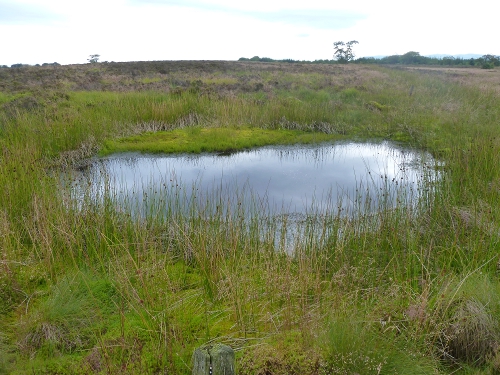Hello gorgeous nature enthusiasts! Daisy is here to update you on our precious Scottish peatlands.
July is disappointingly cool and muggy, but the show must go on. I’ve been out on some lowland raised bogs in Falkirk, checking up on them to see what state they are in and honing my surveying skills.

A gorgeous pool on Newcraig Moss in Falkirk
Falkirk has a LOT of bogs – 40 are listed in a lowland raised bog inventory from the 1990’s and these don’t include other bog habitats such as blanket and intermediate bogs. Sadly, most of these sites are pretty badly damaged and very few have been awarded any meaningful protection. Many of the sites I have visited have been very badly damaged to the extent that some are completely covered by trees or have been converted to grassland for cattle grazing. Others are simply neglected and are suffering from erosion or have been drained and subsequently taken over by heather.
When I visit these sites, despite their wear and tear, I find myself stopping every few metres to marvel at a ruby-like sundew (their slender flower spikes are in bloom at the moment) or a magnificent tapestry of bog mosses in golden, wine-red or vinegary hues. I often catch a glimpse of a common lizard, whipping out of sight into the heather, and all kinds of bees, spiders, craneflies and day-flying moths are making the most of what the mire has to offer. There is hope, because the foundations are still there. The peat-building mosses occupy whatever moist ground is still available, and with just a few modifications (blocking the ditches that sap the bog of rainwater, removing trees etc.) we could start to see a shift towards more typical vegetation communities.
An unexpected and indescribably exhilarating discovery was made last week during a Bio Blitz at Wester Moss SSSI (Butterfly Conservation’s new Large Heath butterfly reserve in Stirling). The event was jointly organised by Stirling Council’s rangers, Butterfly Conservation Scotland, Buglife and BTCV. We had a fantastic turnout – 50 people in total, including members of the local community in Fallin, the Nature Society from Stirling University, and a smattering of botanists, entomologists, birders and general enthusiasts. The weather was uncharacteristically tropical, which meant that there were Large Heath butterflies on the wing, as well as many other delights. We split up into teams, with me tackling the bog and Suzie Bairner (former NT apprentice and new Project Officer for Buglife) leading a blitz of the adjacent colliery bing.
As others tackled airborne beasts, large spiders and ants, I focussed on the minute creatures roaming the moss hummocks. I caught myself some springtails, tiny flies and ants before I noticed a miniature jumping spider just before it pinged away into the vegetation. My memory jolted back to the previous week when we had collected what we thought were Bog Sun-jumpers (Heliophanus dampfi) – a 3mm long black jumping spider with luminous green palps. It is considered to be quite a rare beast and has previously been recorded at only three sites in the UK, two of which being nearby Flanders Ochtertyre Mosses. I eagerly called over David Pryce from Perth Museum, who I have teamed up with to hunt for bugs in the past. David has a “BugVac”, a converted leaf-blower that sucks up invertebrates from vegetation. David set to work hoovering the cotton-grass tussocks that this species seems to favour.
.jpg)
The Bog Sun-Jumper (Heliophanus dampfi), photo kindly donated by Lorne Gill (Scottish Natural Heritage) who attended the Bio Blitz
The following day, Chris Cathrine (Buglife Conservation Assistant Scotland) identified the spider as Heliophanus dampfi under the microscope. It is very exciting to find this spider thriving at a new site and I am keen to visit other bogs in the local area to see if it is lurking elsewhere.
Discovering the spider at Wester Moss highlights the importance of lowland raised bogs as habitats for invertebrates (particularly bog specialists) as well as the merit of Bio Blitz events and biological recording in general. If we don’t know what’s out there, then how can we protect these species?
